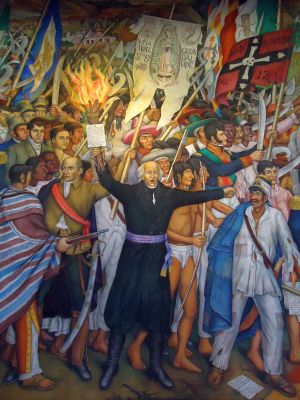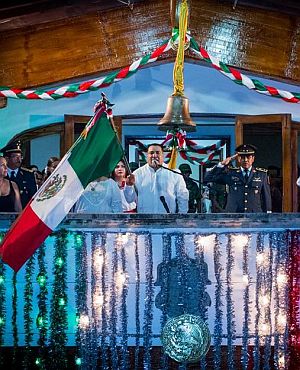The time of Mexico’s most patriotic celebration is once again upon us as Saturday, September 16th marks Mexico’s 207th Independence Day. Millions will kick off the celebration Friday night at 11 pm with ‘El Grito de la Independencia’ (Cry of Independence) — but do you know its history?
The Beginning: Querétaro Conspiracy
By 1810, a couple of failed attempts by Creole (Mexican-born Spaniards) leaders to secure Mexican independence had already taken place, but discontent was high. The town of Querétaro soon developed its own group of men and women in favor of independence. Its leader was Ignacio Allende, a Creole officer with the local military regiment. The members of the group felt they needed another member: someone with moral authority, a good relationship with the poor, and decent contacts in neighboring towns. Miguel Hidalgo y Costilla was recruited and joined sometime in early 1810.
Miguel Hidalgo y Costilla
Father Miguel Hidalgo was a fifty-seven year old Creole who was beloved by his parishioners for his tireless efforts on their behalf. He was considered one of the leading religious minds of Mexico, having served as rector of the San Nicolas Obisbo academy.
He had been banished to Dolores for his questionable record in the church: namely fathering children and reading prohibited books. He had suffered personally under the Spanish system: his family had been ruined when the crown forced the church to call in debts. He was a believer in the new philosophy that stated that it was allowable to overthrow unjust tyrants.
The fifty-seven-year-old priest from an old family of criollos (Mexican-born Spaniards) had suddenly begun to harangue his parishioners in the small town of Dolores in the state of Guanajuato, “seducing them” (according to a chronicle of the time) to rise up in arms – even with stones, slings, sticks or spears – in order to defend their religion against the “French heretics” who had occupied Spain since 1808 and now threatened to come over to the Americas.
What Hidalgo intended – and accomplished – was to launch his flock against the hated gachupines (Spaniards born in Spain and living in Mexico) “who had been exploiting the wealth of the Mexican people with the greatest injustice for three hundred years.”

Miguel Hidalgo y Costilla illustration (Google)
El Grito de Dolores
 |
On September 15, 1810, the conspirators received the bad news: their conspiracy had been found out. Their original leader, Ignacio Allende, was in Dolores at the time and wanted to go into hiding, but Hidalgo convinced him that the right option was to go forward.
On the morning of September 16, 1810, the parish priest of the town of Dolores, Miguel Hidalgo y Costilla called mass. It was attended by about 300, including hacienda owners, local politicians and Spaniards.
Here, he rang the church bells, summoning the workers from the nearby fields, and exhorted his following to take up arms and join him in his fight against the injustices of the Spanish colonial system. Within moments he had an army of some 600 men.
From the pulpit he announced the revolution: “Know this, my children, that knowing your patriotism, I have put myself at the head of a movement begun some hours ago, to wrest away power from the Europeans and give it to you.” The people responded enthusiastically.
He declared himself in open revolt against Spanish rule from the pulpit of his church, launching the Mexican War of Independence.
This action became known as the “Grito de Dolores” or “Cry of Dolores” and today Mexicans celebrate September 16 as their Independence Day. He had been joined by more than fifty thousand men, mainly Indians from the poorest levels of society.
His Death (but not the spirit)
In July of 1811, Father Miguel Hidalgo was tried by the Inquisition, condemned by the civil authorities, and executed.
But the seed had begun to sprout. It took the form of a long and violent social earthquake, almost without precedent in New Spain or the Americas: the Mexican War of Independence – a truly popular movement led by four hundred armed parish priests – only to be compared in its fury with the uprising of black slaves in Santo Domingo in 1801, and the 1781 Indian rebellion of Tupac Amaru in Peru.
According to witnesses present at the original event, Hidalgo and then his followers had shouted “¡Mueran los gachupines! Viva la Virgen de Guadalupe!” (“Death to the Spaniards! Long live the Virgin of Guadalupe!”), but after one hundred years, time, good manners, and the secularization had transformed the ritual from the call for a holy war, to a peaceful, patriotic affirmation.
The War Begins
The Battle of Guanajuato, the first major engagement of the insurgency, occurred 4 days later. Mexico’s independence would not be effectively declared from Spain in the Declaration of Independence of the Mexican Empire until September 27, 1821, after a decade of war.

Grito at the Zocalo 2013 (Photo: Animal Político)
Official Holiday
 |
Each year at around 11:00 on the night of September 15, the President of Mexico rings the bell of the National Palace in Mexico City. After the ringing of the bell, he repeats a cry of patriotism (El Grito Mexicano) based upon the “Grito de Dolores,” with the names of the important heroes of the Mexican War of Independence and ending with the threefold shout of ¡Viva México! from the balcony of the palace to the assembled crowd in the Plaza de la Constitución, or Zócalo, one of the world’s largest public plazas.
After the shouting, he rings the bell again and waves the Flag of Mexico to the applause of the crowd. This is followed by the playing and mass singing of the Himno Nacional Mexicano, the national anthem. This event draws up to half a million spectators from all over Mexico and tourists worldwide. On the morning of September 16, or Independence Day, the national military parade starts in the Zócalo, passes the Hidalgo Memorial and ends on the Paseo de la Reforma, Mexico City’s main boulevard.
A similar celebration occurs in cities and towns all over Mexico, and in Mexican embassies and consulates worldwide, on the 15th or the 16th. The mayor (or governor, in the case of state capitals, and ambassadors or consuls in the case of overseas celebrations,) rings a bell and gives the traditional words, with the names of Mexican independence heroes included, ending with the threefold shout of Viva Mexico!, the bell ringing for the second time, the waving of the Mexican flag and the mass singing of the National Anthem by everyone in attendance.
In the 19th century, it became common practice for Mexican presidents in their final year in office to re-enact the Grito in Dolores Hidalgo, rather than in the National Palace. President Calderón officiated at the Grito in Dolores Hidalgo as part of the bicentennial celebrations on September 16, 2010, after launching the national bicentennial celebrations from the National Palace balcony on the night of the 15th. As a result, the 2011 commemoration was held on the National Palace balcony instead.
The following day, September 16 is Independence Day in Mexico and is considered a patriotic holiday, or Fiesta Patria (literally, holiday of the Fatherland.) This day is marked by parades, patriotic programs, drum & bugle and marching band competitions, special programs on the national and local media outlets, and even concerts.


